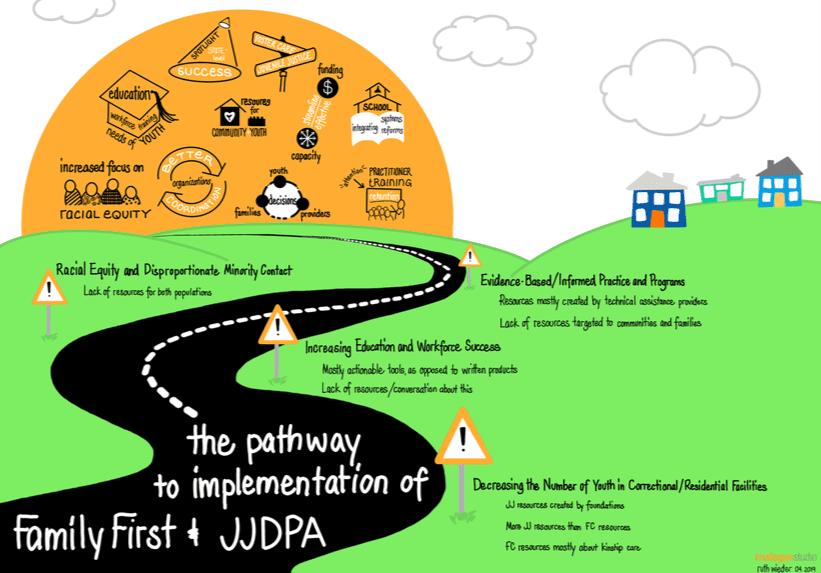Discussion Group Materials
State Presentations
- State Presentation#1: Preparing for the Family First Prevention Services Act: How Connecticut Safely Reduced their use of Congregate Care
- State Presentation#2: Utilizing a Multidisciplinary and Collaborative Approach to Child Welfare Transformation: Virginia’s Three Branch Model
- State Presentation#3: New Opportunities for Maryland to Strengthen Racial Equity through the Juvenile Justice Delinquency and Prevention Act
Graphic Recording Images
Additional Resources and Speaker Handouts
- Resources for the Family First Prevention Services Act, Capacity Building Center for States
- Children in Kinship Care Findings from Literature, Child Focus
- Current State of Juvenile Justice-Education Reentry Efforts, National League of Cities
- Lessons Learned: Mayoral Leadership for Juvenile Justice, National League of Cities
Overview
The landmark Family First Prevention Services Act (FFPSA) and the Juvenile Justice Delinquency and Prevention Act (JJDPA) reauthorization provides new opportunities to strengthen support services for systems-involved youth through the use of evidence-based programs and practices. As organizations, advocates, and other stakeholders work to develop resources that can support the new legislation and states prepare for implementation, it is critical to assess how these policies will impact older youth in the juvenile justice and child welfare system and the role that organizations are playing in developing resources to complement the new policies.
This discussion group brought together government and nonprofit organizations to strategically map and identify resources that are currently available and being used, as well as identify new tools that are needed to help promote better outcomes for systems-involved youth. We heard from state child welfare and juvenile justice leaders. The speakers shared their approach for implementation and discussed both the challenges and exciting opportunities for states to reform their systems. We ended with an interactive mapping exercise to identify current and future products that are needed and collectively identify the resource gaps within the child welfare and juvenile justice systems. We had a graphic recorder present to capture our journey and help organize our thoughts and next steps.
The goals of this discussion group included:
- Hearing from state leaders and organizations about the greatest challenges and opportunities within the FFPSA and the JJDPA.
- Taking inventory of the current resources available to states and other stakeholders to support the implementation of the FFPSA and the JJDPA.
- Identifying gaps in resources and potential tools that could help states and stakeholders implement the new federal legislation.




